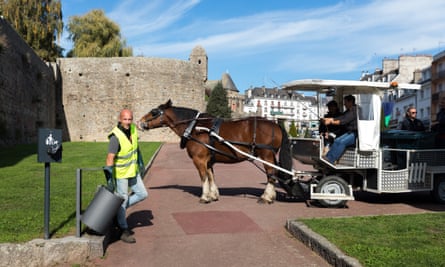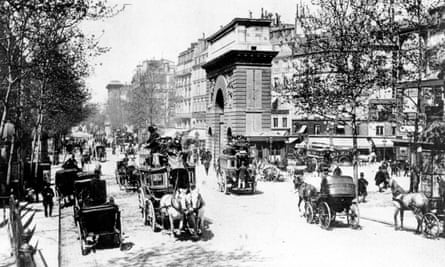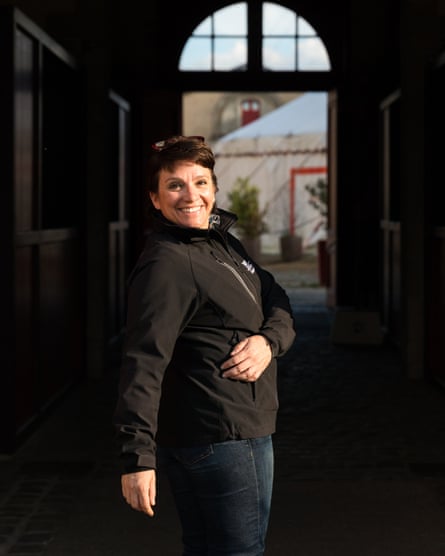
The clip-clop of hooves marked the begin of the early morning garbage selection in the Brittany town of Hennebont, as Dispar, a Breton draft horse, pulled a small cart in direction of the waste bins on a central avenue.
“This job is so considerably nicer with an animal,” claimed Julien, 38, who commonly worked emptying bins on to a motorised rubbish-truck in a further town but was instruction in horse-drawn strategies. “People see you differently, they say howdy as a substitute of beeping. This is the future, it saves on air pollution, petrol and noise. And it will make people today smile. Normally, I’d be consistently breathing in exhaust fumes guiding my lorry, so this feels much more healthy.”
Faced with local climate breakdown, the strength crisis, and modern-day tension amounts, there is a rising movement in French cities to deliver again the horse and cart as an different to fossil fuels and a way to gradual down city lifetime.
Florence, an estate agent in Hennebont, generally stepped out of her business to look at the horse-drawn bin cart move. “When I hear the audio of the hooves it’s just complete happiness to me,” she stated. “It delivers a sort of mild calm in these frantic occasions. It delivers a little bit of poetry into everyday lifestyle, a reminder that issues can be additional straightforward. If I could dwell in a globe without vehicles, I would.”
Due to the fact the 1st trials to reintroduce draft horses for municipal tasks in the mid-1990s, the range of French towns and city spots employing them has multiplied by nearly 20 and continues to increase. Up to 200 urban regions have utilized draft horses in modern decades. The most recurrent jobs are garbage assortment and horse-drawn carriages using kids to faculty.
In the southern town of Vendargues, exactly where the horse-drawn faculty carts are so well-liked that ready lists have been 100 families-extended, a analyze identified they experienced enhanced the children’s marriage to learning. Some youngsters who could wander or cycle to faculty preferred travelling by horse-drawn cart, regardless of it getting longer, mainly because they observed it “calming”.

Municipal draft horses have also been utilized for the routine maintenance of green areas, public transport to markets, neighborhood forestry function and gathering Christmas trees for recycling. Most towns applying draft-horses are middle-sized, with many throughout northern France. In parallel, there has been an raise in the agricultural use of horses and donkeys, with hundreds at present utilised in vineyards and for sector gardening. Carriage driving, which was at the time a man’s domain, is significantly attracting gals.
Neighborhood politicians like the symbolism of a horse to present they are performing for the natural environment. As one stated, horses convey a “feel-good factor”. But the use of draft horses stays pushed by specific cities, and some neighborhood figures would like to see the point out give more centralised backing and title horsepower as an formal type of option strength.

Cities argue they are not pushed by nostalgia. At the begin of the 20th century, there was just one horse for every 5 persons in France, and draft horses typically did perilous operate in field or down mines.
“It’s absolutely not a return to the past,” reported Vanina Deneux-Le Barh, a sociologist at the French Institute for Horses and Using. “It’s a sustainable enhancement strategy, about respecting mother nature and welfare in new, impressive ways – for illustration with electric help for horses going up gradients, or with development in new forms of harnessing.”
Hennebont, a city of 15,000 individuals in the west of Brittany, is the newest to supply a new schooling scheme for municipal horses, carriage drivers and nearby authority employees. Its municipal Breton draft horses, Dispar and Circus, are brothers aged 8 and 9 who weigh about 900kg (1,984lb) each, and live outdoor in a broad paddock with constrained work several hours. Their plodding rate, at 6-8km/h (3.7-5mph), contains transporting children from an following-college club to the canteen, taking shoppers to industry, things to do at a regional care dwelling and amassing garbage. But a lot of their time is used resting.
Morgane Perlade, a carriage driver, coordinates Hennebont’s unique services to use the horses throughout all parts of urban lifestyle. “The existence of a horse rehumanises a city,” she stated. “If the city corridor wants to conduct a survey on the renovation of a housing estate, they might not get quite a few replies. But if we bring a horse alongside to the housing estate, anyone will arrive in excess of to communicate and answer the study.” For cultural gatherings and festivals, “if we provide horse-drawn transportation, all the sites are filled”, Perlade extra.

Attitudes toward rubbish assortment have modified, with neighborhood people environment apart their glass bottles to make it a lot easier for the horse-drawn workers. “I’m not absolutely sure they would do the same for a bin lorry,” Perlade claimed.
“We feel that we’re making the famous put up-covid globe,” claimed André Hartereau, a previous mayor now included in the community authority’s managing of Hennebont’s countrywide stud farm. Horses could neither supply all the answers to the emissions trouble, nor swap all motor vehicles, he said, “but what we can do is significant … A horse has no carbon imprint on the surroundings, it is not a ruminant like a cow. Expenses can be reduced than investing in motorised transport. The constraint for towns is currently being able to give adequate area for the horses.”
Utilizing horses in city settings is also witnessed as a way to protect France’s nine draft-horse breeds, whose quantities are declining. French draft horses continue on to be bred in element for the meat industry, which includes export to international locations like Japan, but in France intake of horse meat is declining.
At the nearby treatment house, citizens have normal visits from Hennebont’s municipal horses. “Some individuals listed here who seldom speak in phrases will say full sentences when speaking to a horse,” reported Magali, a treatment-residence coordinator. She stated that when the horse and cart arrived to transportation citizens to cultural activities, they would dress up neatly, in a way they did not do for the minibus. “It’s specific,” Magali included.

Bernadette Lizet, an ethnologist and historian of draft horses, reported their return to the urban landscape was rooted in developing international concern to guard biodiversity. Draft horses remain well known with the public, simply because “they nonetheless stand for a connection concerning generations”, stated Lizet. “Horses disappeared from farming life in France rather just lately, it’s the 60s, 70s, even 80s. Their existence signifies a relationship amongst old and young.”
Véronique, 73, a pensioner who experienced retired to Hennebont from Paris, stated: “Just the seem of the horse crossing the city would make me happy for my grandchildren.”
Maurice Lechard, a town corridor official from nearby Inzinzac-Lochrist, who was observing the horse education, stated equine remedy was demonstrated to make individuals feel greater. “Having horses in a town usually means sprinkling a little bit of that across day to day lifetime.”








